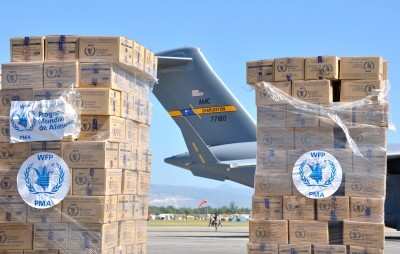Coordination Of Relief Supplies And Logistics A Challange
When a disaster strikes, people assume it should be easy to get
relief supplies in. But it's not always a simple proposition. Can
the airport's runway support the weight of cargo aircraft? What is
the security situation like? What equipment does the airport have
for unloading and loading? How many people and the means to support
and supply them will be needed?

All of these questions and more are in the realm of Joint Task
Force Port Opening at Toussaint L'Overture International Airport
here. The unit, operating under U.S. Transportation Command, opened
the airport after the magnitude 7 earthquake that hit Haiti Jan. 12
and has been responsible for operations on the airport's ramp since
then.
The task force contains the Air Force's 621st Contingency
Response Group, from Joint Base McGuire-Dix-Lakehurst, N.J., and
the Army's 688th Transportation Detachment for rapid port opening
from Fort Eustis, VA. The disaster in Haiti marks the first time
"the whole enchilada" has been used in an operation, said Air Force
Col. Patrick Hollrah, the task force commander. "Something of this
magnitude takes the whole team to make it happen," he said during a
recent interview. "This is, unfortunately, what we were made to do.
It is our job to respond to these."
The unit was the second one on the ground after the Air Force
Special Operations Command team. "[The special operations team]
brought a special tactics team with them that was restoring order
and starting to control the airflow in," Hollrah said. "There were
literally airplanes parked everywhere."
The terminal building, while still standing, has cracks all
through it and cannot be used. Aircraft parked where they could and
crews improvised the unloading process. That caused confusion
beyond belief, the colonel said. Relief supplies got intermixed and
trucks drove straight down the ramp to load supplies. "We started
working in tandem [with the Air Force special operations team] to
get airplanes unloaded so they could get off the ramp to clear off
parking spaces so more airplanes could come in," Hollrah said.

It was a short time from order to execution, so the team
surveyed the area on the flight down to Haiti and had an idea of
how they wanted to set up the unit. "The biggest challenge was the
volume of air traffic, volume of vehicles and the volume of people
on an airport ramp," he said. "Anywhere else, a ramp is a
restricted area. Not here."
The unit is trying to get control of the safety and distribution
parts of the equation, but it is slow going. "Eventually, we'll get
back to a point that improves safety and allows the traffic to flow
where it needs to when it needs to," Hollrah said. "It will also
make the unloading and distribution process faster."
Aerial port airmen unload the aircraft and move the goods off
the ramp. Army vehicles take the goods and move them to a forward
distribution node, about a mile away. "This opens up the ramp space
and stops having trucks drive right on the ramp to pick up
supplies," said Army Maj. Vicky Snow, the 688th commander. The
soldiers stack the goods and, using rough-terrain forklifts, load
trucks from governmental and nongovernmental agencies. By far, the
most goods in the supply yard belong to the U.S. Agency for
International Development, which is responsible for picking up the
relief supplies and distributing them. That process is moving
smoothly.
Nongovernmental agencies also pick up their goods at the yard,
and this can be more of a problem. In one case, someone donated a
plane to airlift supplies to the effort, and several organizations
placed goods aboard it without tracking numbers, or even labels.
"Separating these out and ensuring they go to who they belong to
can cause problems," Snow said. "In other cases, they don't have
the right trucks to load with a forklift, so we have to break down
the palettes and load [the vehicles] by hand. This takes time."

These are small units. "We have all our people cross-trained,
and everybody pitches in to ensure the mission gets done," Hollrah
said. "We're a bridging force that can come in quickly to get the
process started. Then we turn the responsibility over to government
or non-governmental agencies." The unit not only handles supplies
coming in, but also helps the State Department with refugees
getting out. "We have a high-volume evacuation of American
citizens," said Air Force Maj. Matt Jones, the task force's
operations officer. "We've been averaging 1,200 American citizens
per day that have been getting on U.S. military and commercial
aircraft and getting back home."
Before the earthquake, the airport saw 30 flights on a busy day,
and those were mostly during daylight. At its peak, since the
disaster, the airport received 120 flights per day 24 hours a day.
The most recent statistics show the airport has handled at least 12
million pounds of relief supplies, and this does not count critical
supplies that medical and relief personnel brought with them.
The joint task force will continue until its services are no
longer needed, Hollrah said, or until the mission is taken over by
other organizations.
 ANN's Daily Aero-Term (04.14.24): Maximum Authorized Altitude
ANN's Daily Aero-Term (04.14.24): Maximum Authorized Altitude ANN's Daily Aero-Linx (04.14.24)
ANN's Daily Aero-Linx (04.14.24) Classic Aero-TV: 'We're Surviving'-- Kyle Franklin Describes Airshow Life 2013
Classic Aero-TV: 'We're Surviving'-- Kyle Franklin Describes Airshow Life 2013 Aero-News: Quote of the Day (04.14.24)
Aero-News: Quote of the Day (04.14.24) Airborne 04.09.24: SnF24!, Piper-DeltaHawk!, Fisher Update, Junkers
Airborne 04.09.24: SnF24!, Piper-DeltaHawk!, Fisher Update, Junkers





